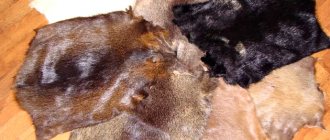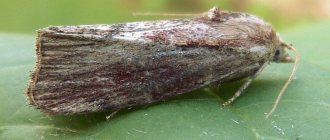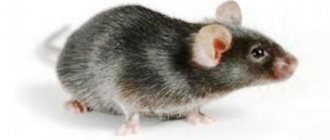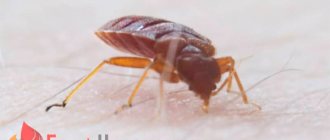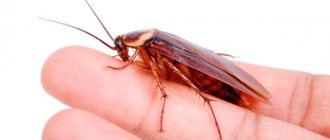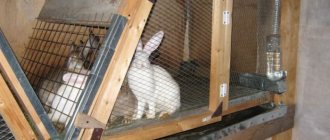Ear mites in rabbits cause the development of ear scabies and psoroptosis.
The pathology is characterized by itching and the formation of scabs on the ears of animals; scratching with claws leads to the appearance of wounds and the addition of a secondary infection.
The disease causes damage to farms: young animals infected by their mother often die, the weight and reproduction of breeding animals decrease, and the quality of hides and meat deteriorates.
The simple form is treated with antiparasitic agents while preventive measures are taken to prevent infection.
Ear scabs (scabies)
One of the common causes that can ultimately lead to the death of a pet is psoroptosis or ear scabies.
Psoroptosis in rabbits develops quickly, so help should be provided immediately. This disease is contagious, so there is a risk that ear scabies in rabbits will spread from a sick pet to healthy ones.
Why does psoroptosis occur? It's all about special mites of the genus Psoroptes, which gave the name to the disease. These yellow oval-shaped mites are small in size - less than a millimeter.
Despite this, they are extremely dangerous for a rabbit's ear. Ticks feed on blood, and rabbits' ears are known to contain a network of blood vessels.
This explains why mites infest the ear or ear canal. One tick bite is enough to provoke the disease.
This method of infection is the most common. Sometimes mites can be carried on the rabbit's owner or equipment that has not been thoroughly treated.
Little rabbits can become infected from their parents. As a rule, tick activity occurs in winter and spring.
At the same time, rabbits that are kept in a cramped and damp place, receive poor nutrition, and have other diseases, including helminthiasis - lesions from parasitic worms, are at risk.
Symptoms of psoroptosis include discomfort that the rabbit feels. This feeling prompts the animal to scratch the skin around the ears, which leads to damage to this area.
Since the scratching wound is open, infection can get there, leading to otitis media and brain damage. If it comes to the latter, then this will be clearly visible due to the corresponding symptoms indicating damage to the central nervous system.
However, giving treatment in this case is, as a rule, useless, since such a disease in most cases leads to death.
How to recognize a tick?
For a mite to adapt to the space of the ear canal, it will take a maximum of 5 days. After this, the activity of the parasite increases, which provokes the first symptoms that appear in the rabbit.
Among them:
- restless state;
- head shaking;
- constant friction of the area around the ears;
- friction against the walls of a cage or room.
If there is even the slightest suspicion of psoroptosis, first you need to carefully examine your pet’s ears. A healthy rabbit has smooth and clean ears.
If red bumps appear on them, you should pay special attention to this, since they may be the first symptom.
If ear scabies are identified, and the tubercles are replaced by vesicles containing yellow liquid, then psoroptosis is confirmed. Subsequently, these bubbles will grow and burst, the liquid will flow out and dry out, and a crust will form.
Treatment cannot be neglected, since the crust, or plaque, that forms at the site of accumulation of bubbles will cover the entire ear. In addition, the ear canal will become clogged with wax and pus, however, this symptom occurs if the disease is neglected.
You need to see a veterinarian when the first unpleasant symptoms appear.
The veterinarian will conduct an examination by taking a scraping. Based on the results of the procedure, the specialist will give an accurate diagnosis and prescribe the necessary treatment for the rabbit. In some cases, contacting a veterinarian is not possible. Then you can take a scraping at home.
It is enough to place it under a layer of petroleum jelly, and then, using a magnifying glass, you can see ticks and their movements on it.
How to treat?
During the treatment process, the rabbit must be constantly shown to a specialist so that deterioration does not occur.
It is necessary to strictly follow all instructions from the veterinarian, and also act according to the following plan:
- Anoint the crusts that have formed on the ears with a mixture of glycerin and an alcohol solution of iodine in a ratio of 1:4. In this case, the coating should become softer.
- The limp plaque is removed.
- Once every 3 days, instill the drug “Amitrazine”. Frequent use of drops is harmful because it causes burns.
Before applying the preparations, it is necessary to thoroughly rinse and clean the ears. Usually a positive effect comes after the first procedure, however, if this does not happen, then it is worth repeating their treatment and treatment with special means.
In addition, special ointments, aerosols and sprays have additional effects. In particular, “Dicrezil”, “Acrodex”, “Tsiodrin”, etc. These drugs can be used no more than once a week. If you start treatment on time, your pet will be able to boast of healthy ears.
Treatment with folk remedies
To remove scabs from rabbits' ears, rabbit breeders do not have to turn to pharmaceutical drugs.
You can make a product at home that contains the following components:
- Turpentine;
- Vegetable oil;
- Kerosene.
In this case, the proportion of the constituent elements should be 1:1:1. Turpentine will have the main effect. If not diluted, it may irritate the skin.
After the product is made, you need to take a cotton swab and, dipping it in the solution, apply it to the place in the ears that is affected. The product should be rubbed in using massaging movements.
A solution prepared with your own hands will help both with the initial stage of ear disease in rabbits and at later stages.
If the remedy does not produce results, after a few days, the procedure should be repeated.
As an alternative, experienced rabbit breeders regularly use camphor oil. It also helps the pet get rid of the disease and regain a healthy appearance.
Preventive measures
If you resort to disease prevention in a timely and correct manner, you can avoid negative manifestations in your rabbit’s ears in the future.
To minimize harm from psoroptosis, the following measures must be taken:
- inspect your pet's ears as often as possible;
- once every six months, disinfect the instruments used for examining animals;
- Wash your hands thoroughly after touching a sick rabbit;
- After purchasing a rabbit, place it in quarantine for 20 days, which will allow you to accurately verify the healthy condition of the animal;
- pregnant rabbits should be carefully examined two weeks before giving birth;
- Prevent the presence of flies, fleas and rodents that can carry tick eggs.
The parasite can exist without a host for 24 days, however, sub-zero temperatures help kill it. It is often said that a domestic cat can carry ticks, but this is a myth. Cats are wary of other types of ticks that are not dangerous to rabbits.
Acute inflammatory process
Purulent otitis media is often diagnosed in rabbits. The causes of internal inflammation are hypothermia, fungi or bacteria. The most vulnerable ears are those of rabbits kept in poor conditions. Cold, dirt and poor quality nutrition lead to a sharp decrease in the animal's immunity. If the disease is not treated promptly, the infection can enter the bloodstream. Brain damage is possible.
In some cases, otitis may be a complication of another ear disease. The disease is manifested by the following symptoms:
- the rabbit shakes its ears, tilts its head to the side (by paying attention to which direction the head is tilted, you can understand which ear hurts);
- loss of appetite, lethargy;
- Earwax mixed with pus is actively leaking from the ears.
When otitis media causes severe suffering to a rabbit, it lies on its side and practically does not move. Without an antibiotic, it is almost impossible to defeat the disease.
Myxomatosis
Much more dangerous for a rabbit, in contrast to psoroptosis, is a disease of a viral nature - myxomatosis. Outwardly, it manifests itself in the appearance of “bumps” on the ears, which are similar in size to a pigeon egg. This disease manifests itself during warm seasonal periods.
Mosquitoes and mosquitoes are considered to be its carriers. Myxomatosis is dangerous for both small and adult individuals. In addition, it does not disappear even after the death of the rabbit: it continues to exist in the dead body for about a year.
If the virus is not eliminated in time, it will penetrate the head and paws. In addition, the disease can provoke conjunctivitis with the release of pus, and this causes the eyelids to constantly stick together.
To achieve the desired result and see your pet healthy again, you need to undergo a course of treatment that will last two weeks. After this time, the “bumps” will resolve, and the affected areas of the skin will heal.
However, the ears will finally stop festering in about a month, during which time the rabbit can be dangerous for other individuals, since transmission of the virus to healthy people is possible.
Methods of treatment and prevention
To protect a rabbit from myxomatosis, it is necessary to administer a special vaccine. After the pet is 2.5 months old, veterinarians advise giving such an injection, and after another 3 months repeating the procedure.
The course of treatment consists of taking antibiotics and specially designed immunomodulators that strengthen the immune system.
The wounds on the ears should be coated with an alcohol solution of iodine, and the rabbit itself should be housed separately from other pets for 3 months.
Pathogen and development cycle
Psoroptosis occurs as a result of infection by the ear mite Psoroptos cuniculi. This parasite has a very small body size - up to 0.9 mm. His body is colored yellow.
Ear mite Psoroptos cuniculi
The development cycle of a harmful insect consists of 5 stages: egg - larva - protonymph - teleonymph - adult. The development period for males is 2–2.5 weeks, for females – 2.5–3 weeks. The female individual lays eggs on the surface of the skin of the ears, gluing them with the help of uterine secretions.
The tick itself remains on the animal’s body for up to 3 months, while without the rabbit’s body the tick can survive for 24 days. The pathogen dies at sub-zero temperatures and at +80–100°C.
It will probably be useful for you to learn how to choose the right rabbit when buying for breeding, and also find out which breeds of rabbits to choose for crossing.
Purulent otitis media
This disease, if appropriate measures are not taken to treat the rabbit, can lead to abnormal brain function, and in extreme cases, death.
Therefore, it is necessary to quickly and accurately follow the veterinarian’s instructions to recognize and begin to treat pus.
The following actions are identified that can lead to the development of purulent otitis media:
- head injuries;
- poor diet;
- hypothermia;
- lethargy and weakness;
- the appearance of parasites, including ear scabies.
The symptoms that are characteristic of purulent otitis are in many ways similar to those that are detected with psoroptosis. However, the first additionally includes the fact that the ears are festering, poor appetite, an abnormal reaction to stroking the ears, and a weakened appearance.
Although the symptoms of these two diseases are similar, the treatment is different. Therefore, in any case, it is necessary to seek advice and help from a veterinarian, who will make an accurate diagnosis and prescribe the necessary medications.
To cure otitis media, special medications are required. Only an experienced specialist can advise them. Therefore, if you choose medications yourself, they can only harm your pet.
Relief of pain and itching occurs by instilling drops into the ears, which relieve inflammation.
Preventive measures
Psoroptosis in rabbits can be prevented by following simple preventive measures.
Among them:
- Do not use straw as bedding, as it may harbor ticks.
- Periodically treat the cells with acaricidal agents.
- Provide rabbits with a balanced diet.
- Do not allow animals to be kept crowded.
- Newly acquired rabbits must be quarantined for at least 2 weeks.
- Pregnant females should be treated with products in consultation with a veterinarian 2 weeks before lambing, even in the absence of signs of disease.
- Carry out the necessary vaccinations in a timely manner.
- Periodically give animals vitamin complexes to maintain immunity.
Abalone drop
Although ear drop is common among rabbits, it should not be underestimated. A fall can represent a simple game of an animal or be a symptom of some serious illness.
If one or two bunny ears fall off, they should be carefully inspected, even if they are otherwise in healthy condition. There should be no sores in the ears or on the sinks.
A falling ear can be caused by something getting into the ear canal.
In addition, a fall may be a consequence of the rabbit being shaken by the ears, and this, in turn, negatively affects the functioning of the animal’s nervous and circulatory system.
It can also be caused by heat, since rabbit ears are sensitive to temperature fluctuations. As a rule, due to the heat, the ears of small rabbits droop due to the fact that their cartilaginous frame has not fully formed.
Sometimes the problem lies much deeper - in the pedigree. If the patients had a breed such as “rams” in their family, then the weight of the pets affects the drooping of the ears.
If parasites have settled in the rabbit’s body or a collapse has occurred due to negligence, then this can also be the cause of ear fall. The first requires the necessary treatment course.
In another case, a special design will help, which would serve as a “splint” and help support the ear.
It’s easy to make it yourself: you just need to take foam rubber or glue the fallen ear to another shaped one. This “splint” is necessary for the rabbit for 4 weeks, while he shakes his head as usual, without restrictions.
Treatment methods
Traditional methods
Treatment of the above-described scabies must be carried out with the help of meticulous treatment of the ear canals and the inner walls of the shell, removing dry scabs and mites.
To perform these manipulations, a mixture of several components is most often used, which must be diluted in equal proportions:
- creolin;
- kerosene;
- vegetable oil or glycerin;
- turpentine.
If a mite is detected in rabbits, then treatment using traditional methods is a fairly effective way to cure this disease. Camphor oil can be a great help, using a syringe without a needle to irrigate the inside of the ears. The best results can be achieved with early treatment of the infection.
If there are abundant scabs in the ears of rabbits, then the latter must be softened with hydrogen peroxide or a composition of glycerin and iodine (4:1 ratio). The procedure must be performed once every 2 days.
Treatment with sprays
In addition, when removing ear mites, it is imperative to use medications along with traditional medications. This can be a spray of “Dicrezil”, “Acrodex”, “Dermatosol”, “Tsiodrin” and “Psoroptol”, which must be used to treat the ears at a distance of 12-15 cm for several seconds. To consolidate the result, this manipulation must be repeated after two weeks. With this treatment option, the animal will get rid of such a harmful and dangerous parasite as ear mites.
All these drugs have antiparasitic properties and are used against various types of ticks. These medications are most effective against scabies mites. Using these sprays, it is necessary to treat the entire surface of the auricle.
Most often, animals react calmly to this treatment, but on the first day after using the product, veterinarians advise observing the behavior of the animals. These aerosols are typically 85% effective after the first use. Repeated treatment of infected organs allows you to completely get rid of ticks.
Using drops and injections
Treatment in rabbits can be done with Dekta drops and Baymek or Ivomek injections. The drugs Selamectin and Ivermectin, which are intended for the treatment of cats and dogs, are effective and are also well tolerated by rabbits. After one use, cure is noted in 85% of cases.
Application of emulsion
Valekson is widely used. This emulsion is used to combat a large number of parasites. The entire ear surface is treated. The procedure must be repeated after one week. Ear mites can be treated in 10-14 days. In addition, Neotsidol and Chlorophos are used.
One way or another, before using folk mixtures or professional remedies, it is best to consult a veterinarian. To prevent ear mites, you need to treat a pregnant rabbit. Even if there were no signs of illness. Without severe symptoms, the incubation period lasts one week.
If female rabbits become infected from young rabbits, they must be removed, treated, and only then can they be returned. The ear should be examined regularly. The cages must be kept clean, food debris must be removed promptly, and bedding must be replaced.
https://youtube.com/watch?v=Wl2SsBSosEk
Earwax
If your pet's ears are filled with wax, you just need to remove it. However, this must be done affectionately so that the animal is not frightened and harmed.
The process of cleaning the ears consists of several steps:
- Carefully bend the edge of the ear.
- Taking a cotton swab, remove the wax. In this case, there is no need to climb inside the ear.
- Carefully examine the ears and determine whether there is redness or peeling on them. The skin should have a pale pink tint. If abscesses or redness are found on the ear, you should take your pet to the veterinarian. If sulfur has an unusual smell, this may mean that parasites have settled in the ear.
Common diseases of rabbits
In the first 30 days after birth, rabbits have very high immunity and are not susceptible to infection. But the death of young animals in the first month still often happens. Among the reasons are:
- low temperature in the queen cell;
- lack of milk in the rabbit;
- unsanitary conditions in the place of detention.
Rabbits older than 1 month suffer from the same diseases as adults. But, unfortunately, young animals suffer from diseases more acutely, so mass deaths of young offspring often occur.
Video TOP 5 FATAL DISEASES OF RABBITS
Hypothermia
If the ears are swollen, it means they have received a dose of hypothermia. You can help your pet in this situation by rubbing its ears and then bringing it into a warm room.
After the ears become dry and warm, you should treat them with Vaseline. An alternative is camphor oil. When bubbles burst and become scabby, the second stage begins.
It is necessary to open the bubbles and lubricate the inflamed areas. To do this, use an ointment based on camphor, zinc or iodine.
If the third stage of hypothermia has begun, the skin of the ears begins to wrinkle and dry out. Tissue cells die and must be removed. The pet itself must be placed on warm straw.
Frostbitten ears
Rabbits experience frostbite on the tips of their ears if left in a cold place with insufficient protection from wind, drafts and moisture. If a rabbit becomes wet from rain and the temperature drops below zero, the animal may suffer from hypothermia or frostbite. In addition to the tips of the ears, the feet get frostbitten.
Stages of frostbite and treatment
At the first stage of frostbite, the ears become cold, pain and swelling are observed in the areas of suspected frostbite. Frostbite is easy to treat. Rub your ears with snow. Provide a warm room where the ears can dry. Then, lubricate the damaged areas with camphor ointment, Vaseline or unsalted fat (pork or goose).
At the second stage, blisters with yellow pus appear. The blisters burst, forming long-lasting ulcers. During treatment, the blisters are opened. The resulting wounds are lubricated with zinc, iodide or camphor ointment.
The third stage is characterized by damage to deep tissues. Skin necrosis occurs. Dead areas must be removed to prevent infection. Wounds are lubricated with ointments of the second stage and treated as open.
Insulate the cages with straw and straw mats. Provide newborn rabbits with sufficient bedding and fluff. Rabbits should be able to snuggle up in the nest.
Overheat
As opposed to frostbite, a rabbit can become overheated. This happens if the temperature in the room is higher than normal. To avoid overheating in this case, the pet should be placed in a cool place.
However, if this does not help, then the reason is different and you need to seek help from a veterinarian. If a rabbit’s ear disease is recognized by a specialist, treatment should begin quickly.
The patient is isolated from other pets to avoid infection. However, this does not apply to diseases associated with body temperatures (hypothermia and overheating).
To protect your rabbit from the above dangerous diseases, you need to follow simple preventive measures:
- keep the rabbitry clean;
- inject vaccines on time;
- create a favorable temperature in the rabbitry;
- provide the most healthy and balanced nutrition;
- Only purchased pets should be kept in quarantine for some time.
And also, rabbits should not be given to strangers or allowed near pets brought by guests, since from them the rabbit can become infected or “pick up” a parasite.
Other reasons
A rabbit's ears may itch and crust over due to infection of wounds received during fights or due to negligence. The likelihood of injury increases if nails or sharp edges of metal mesh are protruding into the cage.
When pathogenic microorganisms enter an open wound, an inflammatory process begins, accompanied by the release of pus. Under favorable conditions - weakened immunity, violation of sanitary standards - the focus of inflammation will increase.
Excessive accumulation of wax in the ears also brings discomfort to the animal.
If the accumulation of natural secretions is not accompanied by redness, peeling or an unpleasant odor, there is no cause for concern. It is enough to clean the ear with a cotton swab dipped in hydrogen peroxide or a weak solution of potassium permanganate.
Often found in rabbits, scab is a fungal disease that affects areas of the body that are not covered with hair or have short hair. Another name for the disease is scabies. It is provoked by a fungus of the genus Achorion, which reproduces by spores.
Circle-shaped scabs appear on the animal’s ears, head and paws. The edges of such a “saucer” are slightly higher than the middle part. If you remove the crust, you will notice white dusty contents - these are spores.
The disease can be spread by other pets - cats, dogs, guinea pigs, which are also vulnerable to this fungus.
All animals infected with scabies must be quarantined. The cells where they were kept must be disinfected. The rabbit is considered non-infectious 14 days after complete recovery.
Lumps on the ears
Dense formations on the ears in the form of tumors or bumps in most cases indicate myxomatosis. At the same time, bumps appear throughout the animal’s body, and the appetite decreases or disappears completely. If nothing is done, the individual will die within 10 days.
For an accurate diagnosis and to avoid spreading the virus, call your veterinarian immediately.
general information
Psoroptosis is an ear mite that often infects the ears of domestic rabbits. The causative agent of this disease is an oval yellowish tick. During infection with this disease, the pathogen spreads from the inner walls of the auricle to the area of the ear canal and middle ear. The disease can pass from adult rabbits to young rabbits.
A rabbit can become infected with ear mites through contact with already sick individuals. Infection usually occurs through skin flakes and dandruff, which can fall off along with the parasites.
A rabbit's ears can be affected by various diseases in the presence of the following unfavorable factors:
- crowded content;
- if there is poor feeding, which includes feed mixtures low in vitamins;
- high level of humidity;
- helminthiasis and other infectious pathologies.
The most pronounced signs of psoroptosis appear in spring and autumn.
Sores in the ears
Regardless of the cause of the wounds, they need to be wiped with 3% hydrogen peroxide. When they dry, apply streptocide ointment to the wounds and bandage with a sterile bandage. Try not to tie the bandage too tightly. Repeat the procedure once a day until complete healing.
If the wounds are not mechanical and are accompanied by other symptoms - for example, inappropriate behavior of the rabbit (shakes its head, falls, is inactive, itches intensely), most likely we are talking about ear mites or otitis media.
Veterinarian examination
To identify scabies mites, the doctor uses petroleum jelly, a scraping tool, glass and a magnifying glass. Vaseline is heated to 45°, the scraping is placed there. The sample is examined under a magnifying glass on a glass plate. As a rule, swarming parasites are noticeable under a magnifying glass. This method will help out when it is impossible to conduct laboratory analysis.
Veterinarian examination
Red spots
The appearance of red spots is a sign of a fur mite or the first stages of myxomatosis. In both cases, you will need to show the animal to a doctor. Red spots on the ears may indicate ringworms under the skin (microsporia).
It is easy to remove parasites by lubricating the ears with Fungin, but do not use ointment from a human pharmacy - if it gets into the rabbit’s mouth, the outcome can be worse than microsporia.
The harmful effects of low temperatures
Rabbits are very sensitive to environmental conditions. Temperatures that are too high or too low have a negative impact on their health.
In winter, you can often notice that your rabbit has cold ears. The explanation for this phenomenon is simple - due to poor blood supply to the organ, it is more sensitive to frost.
There are three stages of frostbite. In the first case, the ears first turn red and swell. An attempt to touch them causes a strong reaction from the animal, which indicates painful sensations. After a short time, blisters filled with cloudy liquid appear on the ears - these are symptoms of the second stage. To save the organ, the animal is placed in a warm room. And wounds are treated with healing and disinfectants.
The most dangerous stage for the animal is the third stage, the signs of which are blackened, frostbitten ears. In this case, we are talking about the death of living tissue. Their treatment is to amputate the dead parts, otherwise gangrene will set in. It is no longer possible to completely save the organ.
To prevent the rabbit from freezing its ears, the room in which the cages are located must be protected from wind and drafts. During periods of severe frost, it is recommended to use additional heating.
Cheyletiosis
The pathogen is a close relative of the dangerous parasitic Demodex mite in dogs. The causative agent of cheyletiosis is a microscopic mite that lives on the scalp of rabbits. Characteristic signs are sores and scabs in the form of scaly layers on the skin of the muzzle, neck, and back. The ears are affected only from the outside. Inject ivermectin in a dose of 0.4 ml subcutaneously into an unaffected area of the body at intervals of 5-7 days and make sure that the skin gets better with each injection. Do not treat scabs on a rabbit; they will fall off on their own after the tick is removed.
Read more about cheyletiosis
Photo. Sores in the form of eczema on the skin of a rabbit's ears
Feed poisoning
The literature describes skin syndromes when feeding rabbits potato stillage with solanine. Potato stillage is a secondary product of processing potatoes into alcohol. Used in animal feeding in the form of liquid and dry stillage. When feeding stillage containing the toxin solanine, toxicosis develops. It occurs in the form of damage to the gastrointestinal tract, nervous system and skin form. Most often, sores and scabs develop on the head, around the anus and abdomen. Treatment. There are no antidotes. Give a sorbent, and in case of convulsions, administer the medication Diazepam (0.3 ml IM). For skin lesions, soothing and regenerating ointments such as zinc and hormonal dexamethasone are prescribed. For skin sores, apply a liquid dressing in the form of an aerosol, such as panthenol.


